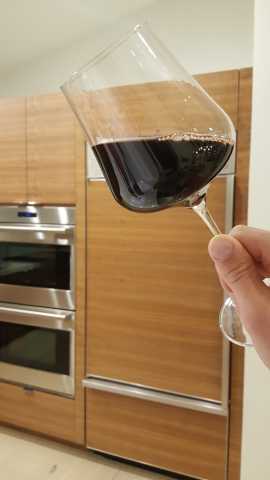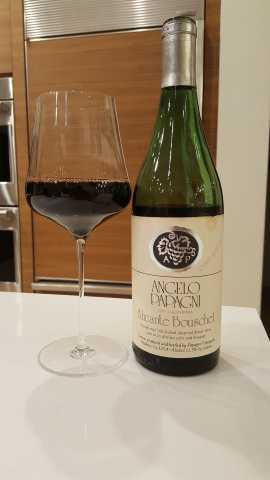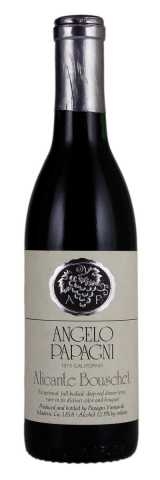Ummmm. Are you kidding me right now!!! Look at the color on this 42 year old wine – black as freaking night!! If you poured this for me blind, I’d literally clock it as a 5 to 7 year old wine max!! I’m blown away just looking at this wine in the glass. Luckily it’s equally as impressive on the nose and palate. Black fruits, tar, violets, and a slight bit of funk (in a good way) on the nose. Blackberries, more tar, earth, and iron on the palate. Full bodied with balancing acidity, and believe it or not…noticeable tannins on the finish!! This must have been a BEAST of a wine when it was young, but it’s seriously awesome right now. Scooped up a few of these at auction (including some magnums) on the cheap, and it’s looking like my deal of the year right now. #HappyCamper


Thanks for the note. I picked up one of these recently as well, along with a late harvest zin. Feeling much more optimistic about them now! The winery has an interesting history ending with Angelo in prison for mislabeling barbera as zinfandel in his white zinfandel. He went to prison for white zinfandel!
Nice Matt! I don’t think you’re going to be dissappointed if you’re shows like mine did, as this was a really good and interesting wine…especially at 42 years old. Would love to hear a note on the late harvest zin if you open it, as I actually snagged one of those as well.
And that’s crazy on the back story! Probably didn’t give him much street cred when the other inmates asked him what he was in for ![]()
Teinturier grape so they usually have very good color.
Quick update. My wife left a small glass on the counter and this is still humming right along today. Fruit has softened while still maintaining complexity. I’m guessing these can age for a while, and since I have 2 left, I’m planning on finding out. Seriously impressive stuff!
Love notes like this. Rich, you’re livin’ right, brother.
Thanks bud! Gotta love it when a bottle you took a flyer on for cheap seriously overperforms!
…almost makes up for the dozens of others that have not ![]()
Great note, Rich!
I take it you don’t need a 2001 Papagni Ali Bou now? ![]()
I have heard that teinturiers lose color quickly, but the one I had definitely still was opaque. Mine had a good amount of tar and berries, with some noticeable strawberry flavors in the glass. The source vineyard in Madera was old, but it was ripped out after the 2001 vintage. Papagni still offers an Alicante Bouschet, just from a younger planting.
I emailed Mr Demetrio Papagni in February, 2016. He responded:
"Regarding the Alicante, although my Father started commercially making Alicante Wine in 1973 and my Grandfather grew it during Prohibition, my 2001 Alicante Wine (see website) was the last vintage from the same vineyard where the vines were a century old! The property has since been developed into homes, however, I have taken the wood from those exact vines and planted them on my ranch in Madera Ca. approx. 5 miles from my winery.
“I encourage you to try this vintage as I believe it is my favorite so far!”
Aside from the last remaining bottle of 2001 Papagni, I am holding onto the Carlisle 2013 Pagani Vineyard and Stillman Brown’s Red Zeppelin “Murder Inc.” Paso Robles.
That’s awesome Drew! As always, I appreciate the details/education.
And I’m with you on the 13 Carlisle alicante. Planning to hold those for a while.
I had a '73 of this about a year ago. A recent purchase I brought to an OL in the wake of a discussion with a couple of the attendees the day before. A fun wine that was certainly outclassed by the other wines we all brought, but quite interesting. It still had this bold “grapey” primary character that is typical of the variety, but under that was a nice fully mature layer. Overall pretty simple. Great environment to try such a wine, but not so much for enjoying it.
The best AB I’ve had was a mature Ridge someone brought many moons ago. The young Carlisle was sort of “Yep. I can see why this is a good blending grape.” Cool that they’re doing it and it should develop well with age.
We got some at the winery one year. Bold, grapey, primary. I was the only one who didn’t hate it. Ended up getting blended. It seems like it’s got to be one of the most challenging grapes to make a good wine out of that is actually capable of doing so. I can see why people thought this was a vinifera-labrusca cross. A recently tried young Norton a friend made was quite similar.
In the late 1980s, I bought a closeout of this wine in magnums, and remember selling them for $7-$8 each. I must have had 50 some cases of it - stacked to the ceiling.
It was still brutally tannic back then, and I kept telling people to throw it in the basement and forget about it for a while - nice to see it developed well. I was such a fan of this wine (and winery).
I can only imagine how massively tannic this wine must have been back then, as it still has a little bite left today!
I snagged a couple magnums as well and plan on letting those rest for a long time. Zero rush even with the 750s. One of the more fun/interesting wines I’ve had in a while!
Rich’s TN of such an old Alicante Bouschet might provide the Wine Berserkers community with rare insight into a greater issue.
The big question is whether Alicante Bouschet merely sustains over the years, or if it actually develops.
I believe we have all read on the WB forum that some individuals believe Petite Sirah rarely evolves. Could a possible parallel be drawn in this case?
I am left wondering if it all depends on the winemaking.
Well done sir!
I remember selling this in the 70s. I think the wine came in a ketchup bottle so you could pat it at one end so some wine would ooze out.
It was not expensive but you could buy good Napa cab for around $8 then.
Yeah, I think site, vintage and winemaking are among the crucial factors. Sounds like the '75 of this was better than the '73. People have figured PS. It doesn’t have to be a monster that takes decades to come around. It can be lighter bodied, lovely, with savory aromatics, ready to drink on release, or more brooding, yet still accessible on release, like a cool climate Syrah. When you pick has a lot to do with how well a wine can evolve. Sometimes traditional of standard picking decisions are dictated by factors that can be resolved by innovations in the vineyard tailored to a specific variety and site. With AB, I’d look to Spain to see if there’s anything notable and inspirational being done there to help look for ideas of what to experiment with.
Drew Goin wrote:
Rich’s TN of such an old Alicante Bouschet might provide the Wine Berserkers community with rare insight into a greater issue.The big question is whether Alicante Bouschet merely sustains over the years, or if it actually develops.
I believe we have all read on the WB forum that some individuals believe Petite Sirah rarely evolves. Could a possible parallel be drawn in this case?
I am left wondering if it all depends on the winemaking.
Alicante Bouschet is one of the predominate varieties of the Alentejo in Portugal. I believe the Alentejo is a much better terroir for it. Ages fantastically. Try an old bottle of Herdade do Mouchao, a dead ringer for a fine old Hermitage. Fruit is foot tread in lagars whole cluster. Their press is a hand cranked basket press built in 1902. Must then placed in old oak and Brazilian satinwood ovals. Bottled after several years. The 2011 is the current release.
Thanks, Eric!
WineBid currently has a handful of Angelo Papagni Alicante Bouschet bottles up for auction, including 375ml’s and 750ml’s of 1973 and '75.

There are single bottles of aged Charbono and a Barbera as well.
I came across this blog post yesterday and it really struck me.
An epiphany resonated within my noggin that I cannot properly express at this moment. However, I do hope that reading the article will help others who struggle with philosophical issues surrounding grape varieties often dismissed as “age-able but not age-worthy”:
In the following piece, author JD Landis recounts his past experiences with Alicante Bouschet. He purchased many cases of Papagni’s 1973 Ali Bou in his younger days, and whittled down his hoard over the following decade.
Years later, he found a 27-year-old bottle of Topolos RRV Alicante Bouschet that he had tucked away and forgotten. Although he was initially disappointed with the agéd wine’s flavors, his patience paid off in spades…
The Cook’s Cook
“The Odd Bottle: Equivocal Hello, Triumphant Farewell”
by J. D. Landis
~2018(?)
"One of the first wines I bought in, as it were, bulk, was a wine made solely from the Alicante Bouschet grape. It was produced by Angelo Papagni at his eponymous winery. I believe I initially bought the 1973 vintage, which was his first, and later the more acclaimed (though few wine writers bothered with it) 1975.
"…I have no idea precisely when I finished my half-dozen cases of Angelo Papagni’s Alicante Bouschet—sometime in the late 1970s/early 1980s. But I do know that I didn’t taste a wine made from the grape again (my heart belonged to Angelo) until a few weeks ago, when I pulled out of the crawlspace a bottle of 1989 Topolos Alicante Bouschet. Younger than the Papagnis from the 1970s, but still, at nearly 30, old enough and peculiar enough to be an Odd Bottle.
"…Those of us who drink wine professionally, whatever that means, must never not try a wine. It would be unethical, foolish, and demeaning to wine itself, which must never be dismissed because of reputation, price, grape variety, label ugliness, foolish name, or popularity. Every wine deserves to be opened and tried, just as does every book. One sip, at least. One sentence read. Then you can toss it away.
"I pretty quickly plugged an aerator onto the bottle and poured. The wine made the hissing, gurgling, air-expelling sound as it came out and then bubbled in the glass. It was, in its forced upon diffusion, improved. Slightly.
"But the next day, with leftovers (beef), it had lost some of its tartness and none of its fruit.
"It got better and better. And then better after that.
"Unusually, I did not refrigerate the bottle between tastings. It simply stood there in a cool winter room with the aerator still stuck in its neck (that perfect cork kept as a souvenir — we have perhaps 10,000 such souvenirs).
"On the third day, with turkey meatballs, slow-roasted tomatoes, and homemade ricotta, it had, finally, lost most of its tartness and become rounded, fruit-burstingly forward, and still, at 27 years old, promising further decades of bottle age.
“Most modest wines should not be aged except for experiments. Some, however, provide as much of a surprise in their old age as an octogenarian turning cartwheels. Which may be a reason to age all modest wines — as in most things in life, the sacrifice of 99 mediocrities is worth a single miracle…”.